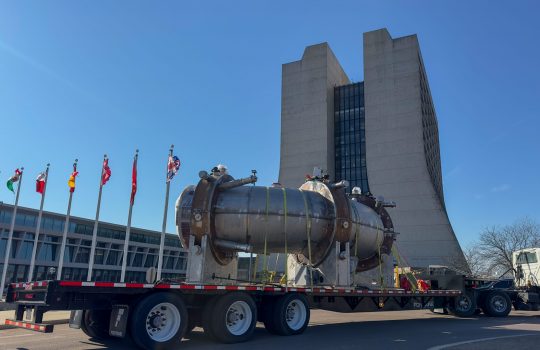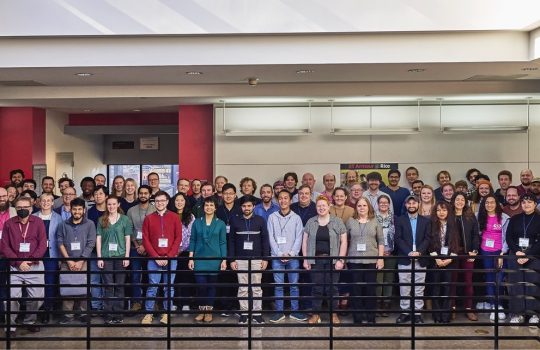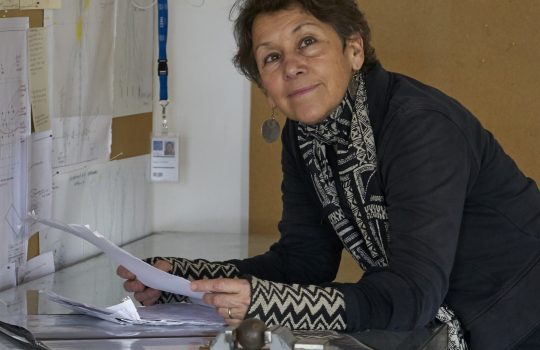Public and media invited to reception launching an exhibit by Fermilab’s artist-in-residence Ellen Sandor
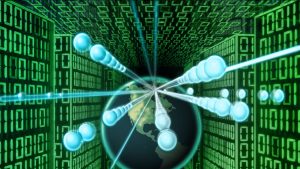
Binary Bypass: Neutrinos for Data Communication, 2016. Ellen Sandor and (art)n, Chris Kemp, Diana Torres, and Janine Fron
A year ago, Chicago artist Ellen Sandor, founder of the (art)n collaborative artists group, was announced as Fermilab’s 2016 artist-in-residence. On Friday, Dec. 2, the public and the media will get the chance to see what she and her (art)n team have been working on, as her exhibit “Neutrinos in a New Light” opens at the Fermilab Art Gallery with a reception from 5-8 p.m. Members of the public and media are invited.
Sandor and (art)n spent months talking with Fermilab scientists and learning about the ways they study subatomic particles called neutrinos. Inspired by the things she saw and heard, she created a series of new works in several different media, works that visualize the invisible science of particle physics. The pieces will be on display at the Fermilab Art Gallery from Dec. 2 through March 17 and are open to the public Monday through Friday, 8 a.m. to 4:30 p.m.
Sandor will present a talk about her work on Wednesday, Dec. 7, at 4 p.m in Fermilab’s Wilson Hall.
Guided tours of the “Neutrinos in a New Light” exhibit will take place on select Saturdays – Dec. 10, Jan. 14, Feb. 18 and March 11 – at 10 a.m. Registration is available online.

Neutrinos and NOvA: A Vasarely Variation, 2016. Ellen Sandor and (art)n, Chris Kemp, Diana Torres and Janine Fron
Sandor and (art)n are perhaps best known as the inventors of a new artistic medium called PHSColograms. These three-dimensional pieces combine photography, holography, sculpture and computer graphics to create immersive experiences, and Sandor and her team have used this technique to visualize particle interactions. Sandor’s exhibit will also include an interactive look inside one of Fermilab’s neutrino detectors. Oculus Rift technology will place you at the heart of the machine, watching neutrinos collide with other particles.
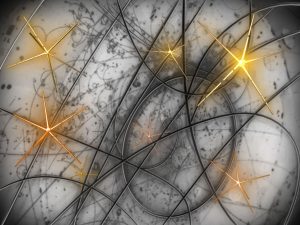
Bubble Chamber Beginnings: Revisiting the Vintage, 2016. Ellen Sandor and (art)n, Chris Kemp, Diana Torres and Janine Fron
Sandor has spent her 40-year career with (art)n giving form to the invisible, using a combination of tools and materials to create vivid portraits of microscopic organisms and show the effects of time on world landmarks. She has a patent for the PHSCologram process, and has used that art form to visualize everything from the AIDS and Ebola viruses to architectural renderings of buildings that were planned but never constructed.
Fermilab’s artist-in-residence program began in 2014. It offers artists the opportunity to get a behind-the-scenes peek at the laboratory and create work based on Fermilab’s scientific research. Artists spend their residence year interviewing scientists and translating what they learn into artwork. The artists then serve as ambassadors to the public, inviting them to look at the science of particle physics from a new perspective.
More information about the Fermilab Art Gallery is available at events.fnal.gov/art-gallery.

